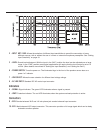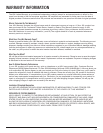
29
Noisy Source Device
Disconnect the devices that are connected to
your speaker one at a time. If the noise goes
away, the problem is with the source or the
connecting cable.
Improper A/C ground or faulty
equipment connect to
mixer input
Disconnect or mute channels one at a time to
isolate the problem. Refer to the owner’s
manual of the faulty equipment for
troubleshooting help.
Faulty cable between source
equipment and mixer
Substitute a known-good cable for the
suspected faulty cable.
Improper A/C grounding,
ground loops
• “Telescope” the audio ground by using an
XLR/F to XLR/M adapter on one end.
• Re-route audio cable away from AC power
and lighting cables.
Excessively long unbalanced
cable run
• Use the balanced outputs (if available) of
your mixer to drive your PRX speakers.
• Use a “DI” (direct injection) box to convert
your unbalanced equipment output to a
balanced output.
Improper system gain
structure
Review the Owner’s Manual for your system
setup and adjust controls as needed.
• Input sensitivity (gain)
Microphones are pointed into
the speakers
Move the speakers to they do not point the
microphone’s pickup pattern.
Equalizer settings are
incorrect
Locate the feedback frequency and reduce it
using the mixer EQ or an external equalizer
Excessive gain
Reduce the gain at the mixer and move the
microphone closer to the sound source.
Recorded music with
excessive low frequencies
Switch the EQ switch to “flat”
Noise or hiss heard at output
Hum or Buzz that increases or
decreases when the mixer level
controls are moved.
Hum or Buzz
Speakers feed back and howl whe
the microphone volume is turned up
Too much low frequencies when
playing back prerecorded music


















